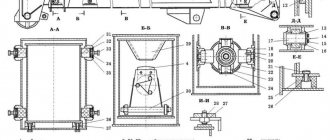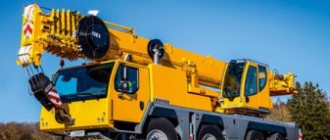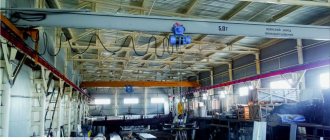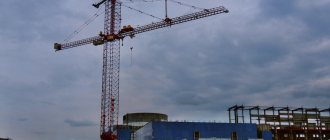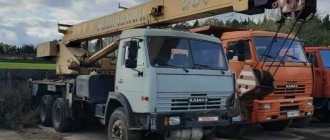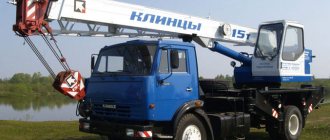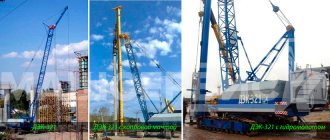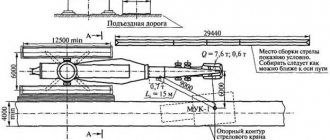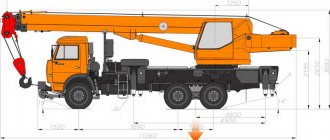The construction crane is selected taking into account the configuration of the site and the object: the availability of space for installation, the laying of paths for movement, the bearing capacity of the soil. When choosing a lifting mechanism, the lifting height, cargo weight, task completion time, and climatic conditions are important. The choice of technology depends on the type and features of the structures. For example, if it is necessary to erect large buildings, tower modifications can be used; if there is loose soil, tracked versions can be used to facilitate the movement of special equipment.
Construction of load-lifting cranes and their varieties
A lifting crane is used for spatial movement of objects that are clinging to hook hangers and other gripping devices. It consists of a box-shaped metal structure or with a lattice cross-section, a lifting mechanism, and a gripping organ. The following types are used in construction:
- stationary;
- tower;
- self-propelled boom;
- special purpose.
The group of boom mechanisms includes: tracked, automobile, pneumatic wheels. With their help, structures and materials are supplied to the site and installation work is carried out. Tower construction cranes are used in the construction of industrial facilities and multi-storey buildings. It lifts loads to a height of 70 meters or more.
The stationary lifting mechanism moves over considerable distances and is used to service large sites. It consists of two structures, between which a rope is stretched for transportation. Another type of stationary construction mechanism is the gantry. It looks like a bridge mounted on two supports. Used for the installation of heavy equipment and the construction of extended monolithic structures.
This is interesting: The design and principle of operation of a pile driving installation
Determining the performance of an assembly crane
We determine the shifting operational productivity for two options.
Psm = Phour · Qsr · tcm · K2
where Phour is the hourly operating productivity.
Qav – weighted average mass of mounted structures;
tcm – shift duration;
K2 – coefficient of transition from hourly to shift productivity.
where: is the sum of the masses of all mounted elements.
n – total number of mounted elements.
where K1 is a coefficient that takes into account intra-shift downtime (0.8-0.9)
Tts.av – weighted average time of one cycle.
The cycle time for installation of structures by type is determined for each option using the formula:
The machine cycle time Tm is determined from the operating conditions of the selected crane during the installation of elements according to the operations: raising and lowering the hook, turning the boom, raising and lowering the boom and moving the crane from the parking lot:
min
where Hpk – hook lifting height;
Hock – height of lowering the hook;
α is the angle of rotation of the crane boom, degrees;
S1 – movement of cargo due to changes in boom radius;
Kc is a coefficient that takes into account the combination of crane operations (75%);
V1 – hook lifting speed;
V2 — hook lowering speed;
nrev – boom rotation speed;
V4 - speed of movement of the crane from one parking lot to another
Farm
Hpk = 9.4 m; Hok = 1 m; α = 180о; Kc = 0.75; V1 = V2 = 5m/min; nob = 0.3;
V4 = 16.2 m/min; S1 = 12
Tr = 33 min
Column
Hpk = 1 m; Hok = 1 m; α = 5o; Kc = 0.75; V1 = V2 = 5m/min; nob = 0.3;
V4 = 16.2 m/min; S1 = 12
Tr = 18 min
Floor slab
Hpk = 12.7 m; Hok = 1 m; α = 180о; Kc = 0.75; V1 = V2 = 5m/min; nob = 0.3;
V4 = 16.2 m/min; S1 = 12
Tr = 15 min
Crane beams
Hpk = 8m; Hok = 1 m; α = 180o; Kc = 0.75; V1 = V2 = 5m/min; nob = 0.3;
V4 = 16.2 m/min; S1 = 12
Tr = 47 min
We set the weighted average cycle time Ttsr, consisting of the sum of manual and machine time, for each type of mounted structures, depending on the quantity, according to the specification of elements, and determine it using the formulas for each option:
where Тм-1 — Тм-n – machine cycle time for mounted structures of each type, min;
Tr-1(1)(2). Тм-n(1)(2) – manual cycle time for the first and second variants of mounted structures of each type, min;
n – number of types of mounted structures (in this case, excluding wall panels);
N is the number of mounted structures in each type.
min
T
t/h
Therefore, operational performance:
Psm = Phour · Qsr · tcm · K2
Psm = 1.89 8.28 8 0.85 = 106.4 t/cm
Popular manufacturers and prices
The average cost of equipment with a lifting capacity of up to 5 tons is 5,500,000 rubles, up to 25 tons - 8,000,000 rubles, up to 50 tons - 15,500,000 rubles.
Among the popular manufacturers of construction crane equipment are: Liebherr, Chelyabinsk Mechanical (Ivanovets truck cranes).
Gantry cranes technical specifications
Types of cranes in construction
How is training carried out and how long does it take to study to become a tower or truck crane operator after 9th grade?
How to make a homemade truck crane with your own hands
How to make a garage goose crane with your own hands
What is meant by the term crane operating cycle?
Other important criteria for choosing a tower crane
New or used
When choosing a crane, the fact whether the crane is new or used is also taken into account. The safety and specificity of the use of tower cranes require the purchase of new models or those that have been in operation for no more than 2-5 years, which receive technical support from the manufacturer. The maximum service life of a tower crane section, depending on the type of steel, is 10-18 years. Therefore, if the age of the crane is less than this period, purchasing a used crane can be profitable, since the cost decreases significantly with increasing service life.
Read
Buying a tower crane: quality or efficiency?
When purchasing a used crane, you should pay attention to the availability of service and components. Almost all manufacturers are constantly modernizing the design of their cranes, and the older the equipment, the more difficult it is to find components. Also, when purchasing a used crane, information about the intensity of past operation is not provided, since the wear and tear of the tower crane structure is affected not by its service life, but by the number of work cycles performed and the weight of the loads. Accounting devices are currently imperfect and cannot fully provide all the necessary information.
Photo source: artfile.ru Incomplete equipment of the crane can complicate its installation and dismantling
Consumers should also be aware of the equipment's post-purchase technical support provisions. Any construction equipment, including tower cranes, needs quick information and technical support from the manufacturer. Currently, in world practice there is no better scheme known than a service and dealer network without internal competition. Almost all European manufacturers care about their reputation and spare no expense in opening such networks, which cannot be said about Chinese companies, of which there are more in China alone than in the whole world.
Delivery time
When choosing a tower crane, delivery times also play an important role. Currently, European manufacturing companies have many orders and offer long delivery times, which, depending on the company, can reach 1.5-2 months in the off-season and 4-6 months at the height of the construction season. In some cases, delivery times can reach one year. Note that some Italian manufacturing companies supply tower cranes either immediately or after 2-3 months.
How to choose a crane for construction
Lifting equipment is the main element of any construction site. Most contractors use rental services for special equipment due to lack of funds to purchase. Indeed, owning a fleet of construction equipment will cost the company quite a lot; in addition, it is advisable to do this only if there is a staff and a considerable volume of orders. A person who decides to rent a lifting mechanism must have the following information:
- what are the required load characteristics of the crane;
- what are the dimensions of the building being constructed;
- is there a possibility of dividing the building into separate sections;
- features and nuances of the territory in which the work will be carried out.
These data will form the basis for the subsequent selection of one or another type of lifting mechanism: whether it will be a tower, truck, portal crane or gantry; crawler crane or self-propelled crane. Let's consider for what purposes this or that type of crane is used. For construction work in buildings with small dimensions (up to four floors), it is preferable to choose truck-mounted cranes or self-propelled cranes. For tall or extended structures, it is better to use a tower crane. If you carry out work on underground structures, then choose portal or gantry cranes. For construction in impassable terrain on loose soils, sandy or marshy soils, lifting mechanisms on a caterpillar chassis are chosen, while for usual conditions, truck cranes are suitable. Today, due to the emergence of a huge number of truck cranes with high productivity, large load capacity and boom reach, choosing a truck crane becomes not easy. Especially if you take into account the versatility of the use of this equipment both in construction and installation and loading and unloading works. Note that you can order truck crane services in Volgograd, Volzhsky, Astrakhan, Rostov, Krasnodar, Stavropol at the best prices. Let's return to the choice of a truck crane tap. We will be interested in the following characteristics:
- What is the crane's lifting capacity? This can be determined by the size and weight of the heaviest building structure at maximum and minimum boom reach.
- What are the dimensions of the crane? This indicator is responsible for whether the equipment and its working elements will be able to move freely within the territory.
- What is the length of the crane boom? What type of arrow is it? This parameter will help you understand whether a truck crane can lift a load.
- Are the structural elements of the crane safe? No comments here.
- What is the design of the chassis? It is determined by the conditions of the work.
In addition, you should have a building plan and a construction site plan as part of the detailed design. Let us remind you that we are engaged in the rental of construction equipment in Volgograd, Volzhsky, Astrakhan, Rostov, Krasnodar, and Stavropol. We are happy to provide any advice regarding construction, installation, loading and unloading works.
Varieties
To choose a load-lifting crane, you need to understand what these machines generally are.
There are 4 main criteria by which cranes are classified:
- mobility;
- design features;
- type of drive;
- chassis.
Each category is worth talking about separately.
Mobility
If we talk about mobility, then the following types of load-lifting crane special equipment are distinguished.
- Stationary. This is how the crane is installed at the site of production and work. Unable to move independently.
- Radial. The design can rotate 360 degrees relative to the fixation point. These are mainly jib cranes.
- Repositionable. Special equipment is used for moving, as well as a group of installation specialists, but the assembly and disassembly process itself is not complicated.
- Self-elevating. This is a category of tower cranes. Takes part in the construction of multi-story high-rise buildings.
- Mobile. This includes all types of self-propelled cranes. They can move to their place of work on their own. They move on their own using tracks or wheels. Also, some are adapted for transportation by rail. These people work in ports. And this also includes trailed cranes, which are towed using tractors. Among them is equipment capable of moving through water.
It is also important to consider that some types of cranes combine several of the presented parameters. This makes them more versatile and multitasking.
Design
Currently, there is a classification that divides cranes into 3 main types.
- Strelov. The load-handling body or trolley is located on the boom. This includes cranes such as portal, point and tower cranes.
- Mostovoy. Here, movable or fixed bridges are used as a support for capturing loads. They are attached at both ends to the rails or to fixed supports. This category includes gantry, semi-portal, gantry, gantry, and stacker cranes.
- Cable. Here, a system of ropes is used as a base for lifting loads. They are attached to supports. The main area of application is the mining industry.
As you can see, here too the crane can have different design features and be included in different classification groups.
Drive unit
According to the type of drive, lifting cranes are:
- manual;
- hydraulic;
- electrical;
- pneumatic.
Manual ones have a low carrying capacity. They are used in small workshops or warehouses.
Three more types take primary energy through the engine, or are powered from a stationary network.
With the help of an internal combustion engine, gas or liquid pressure is pumped into the system, or it is connected to a generator that powers the tap.
In modern production, there is almost no direct mechanical connection between the internal combustion engine and the working mechanisms of lifting cranes. This is an outdated and not particularly reliable technology.
Current lifting cranes are combinations of all the types and subcategories presented.
Chassis
As for the chassis, according to this criterion, cranes are divided into 3 categories:
- Pneumatic chassis. These are self-propelled crane units that move on their own wheels. The maximum speed of movement is 20 kilometers per hour. They are allowed to get to work sites on their own on public roads, but they travel with special escort, as well as at an agreed time and along a route developed in advance.
- Car chassis. Here the crane is mounted on a truck chassis. Usually this is a small technique aimed at performing small volumes of work. But such cranes are the most mobile and have good maneuverability. Can travel on public roads. Accompaniment and an agreed route are usually not required.
- Tracked chassis. The equipment is widely used for work on large construction sites. This chassis does not allow you to move on the roads under your own power. It is necessary to use special transport for delivery to the site.
Don't forget about cranes that don't have a chassis at all. They are placed permanently or installed on railway rails. There is limited movement along them. The latter option can most often be found in sea and river ports for unloading containers, bulk and liquid cargo.
Defining parameters
To determine which equipment will meet all design standards and requirements of the planned structure, it is necessary to take into account the following basic technical parameters:
Parameters of construction jib crane
- chassis design - determined by the conditions of work;
- lifting capacity - the ability to lift the heaviest structural part at maximum and minimum boom reach;
- the volume of the boom’s working area and its length determine the possibility of lifting and moving the load;
- basic dimensions in installed and transport state - determine the maneuverability of the equipment and its maneuverability in the conditions of a given site.
Each of the characteristics is calculated when the construction and work site plan is ready.
Mikhail Voskresensky from Ramenskoye asks:
How is a crane selected for construction based on lifting capacity and type? What parameters to consider when renting equipment so as not to make mistakes?
Our specialist's answer:
The choice of crane for construction is carried out according to the type of chassis, lifting capacity, working area of the boom and its length, and a number of other characteristics. For construction in harsh conditions and impassable terrain, lifting mechanisms on a crawler chassis are usually chosen, while in standard conditions, truck-mounted cranes can cope.
Selection by building height
For the construction of buildings up to three or four floors, equipment on a vehicle chassis is sufficient - its boom length and reach will ensure operation without heavy load. For the construction of multi-storey buildings, tower-type equipment is chosen, but in this case an accurate calculation of the site will be required so that during construction it does not interfere with neighboring houses. If you plan to build on loose soils, sandy or marshy soils, it is better to give preference to a tracked chassis.
Truck cranes are suitable for constructing a building of 3-4 floors
This is interesting: What lubricant to use for a hydraulic hammer
Calculation of technical characteristics
Independent selection of a crane for construction is fraught with errors in the design of work if you do not have the appropriate education. Builders use data such as:
Tower crane calculation
- the mass of the heaviest element - beam, block, etc.;
- mass of grips, traverse, slings;
- weight of mounting equipment;
- design height of already installed elements;
- height of gaps between elements;
- overall dimensions of installed elements.
The required boom reach depends on the position of the mounted elements in the plan and the height of the building, and is also calculated according to the type of equipment design. If it is necessary to carry out calculations for a tower crane, it is more convenient to use graphic images of its position, design and dimensions.
Equipment selected without preliminary calculation will be unsafe to operate and will not provide the required power to perform the necessary operations.
Determining the performance of an assembly crane
We determine the shifting operational productivity for two options.
Psm = Phour · Qsr · tcm · K2
where Phour is the hourly operating productivity.
Qav – weighted average mass of mounted structures;
tcm – shift duration;
K2 – coefficient of transition from hourly to shift productivity.
where: is the sum of the masses of all mounted elements.
n – total number of mounted elements.
where K1 is a coefficient that takes into account intra-shift downtime (0.8-0.9)
Tts.av – weighted average time of one cycle.
The cycle time for installation of structures by type is determined for each option using the formula:
The machine cycle time Tm is determined from the operating conditions of the selected crane during the installation of elements according to the operations: raising and lowering the hook, turning the boom, raising and lowering the boom and moving the crane from the parking lot:
min
where Hpk – hook lifting height;
Hock – height of lowering the hook;
α is the angle of rotation of the crane boom, degrees;
S1 – movement of cargo due to changes in boom radius;
Kc is a coefficient that takes into account the combination of crane operations (75%);
V1 – hook lifting speed;
V2 — hook lowering speed;
nrev – boom rotation speed;
V4 - speed of movement of the crane from one parking lot to another
Farm
Hpk = 9.4 m; Hok = 1 m; α = 180о; Kc = 0.75; V1 = V2 = 5m/min; nob = 0.3;
V4 = 16.2 m/min; S1 = 12
Tr = 33 min
Column
Hpk = 1 m; Hok = 1 m; α = 5o; Kc = 0.75; V1 = V2 = 5m/min; nob = 0.3;
V4 = 16.2 m/min; S1 = 12
Tr = 18 min
Floor slab
Hpk = 12.7 m; Hok = 1 m; α = 180о; Kc = 0.75; V1 = V2 = 5m/min; nob = 0.3;
V4 = 16.2 m/min; S1 = 12
Tr = 15 min
Crane beams
Hpk = 8m; Hok = 1 m; α = 180o; Kc = 0.75; V1 = V2 = 5m/min; nob = 0.3;
V4 = 16.2 m/min; S1 = 12
Tr = 47 min
We set the weighted average cycle time Ttsr, consisting of the sum of manual and machine time, for each type of mounted structures, depending on the quantity, according to the specification of elements, and determine it using the formulas for each option:
where Тм-1 — Тм-n – machine cycle time for mounted structures of each type, min;
Tr-1(1)(2). Тм-n(1)(2) – manual cycle time for the first and second variants of mounted structures of each type, min;
n – number of types of mounted structures (in this case, excluding wall panels);
N is the number of mounted structures in each type.
min
T
t/h
Therefore, operational performance:
Psm = Phour · Qsr · tcm · K2
Psm = 1.89 8.28 8 0.85 = 106.4 t/cm
